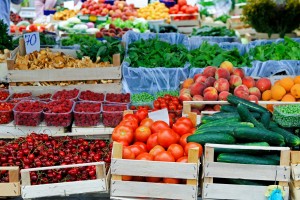You Gotta Eat! Food and Development

I recently attended the ULI Food Forum in New Orleans. Participants included developers, food manufacturers and distribution companies, restaurateurs, and development consultants. The purpose of the Forum was to explore how food is impacting development trends across the country in all sectors of development. Here are some of the opportunities and challenges attendees identified related to food-centered development:
Opportunities:
- Using farming as a community amenity in master planned communities and multi-family projects.
We looked at several examples of farming or gardens as community amenities. These ranged from planting edible landscaping as part of design elements to small community gardens in multi-family developments to full-fledged farms serving as the center of master planned communities (called “agrihoods”). Often the food amenity was combined with walking and piking paths and other soft amenities. Collectively farms and paths cost less than golf courses to build and maintain, although each agrihood did employ a full time “farm manager” or farmer to oversee the operation. Food grown on farms is either available to community members, sold to the public, or donated to food pantries.
- Using small footprint “food stalls”, advertised food truck visits, or short term rentals to diversify and keep customers interested in retail venues.
Food is trendy right now, and consumers are seeking out new and different food experiences. Developers who are able to utilize strategies to offer new or changing food related experiences see an increase in foot traffic in their retail projects. Projects we looked at included a “food incubator” where food manufacturers had short term leases on commercial kitchens and small retail space; projects where food trucks are scheduled and advertised to visit a retail center to create a food themed day; and developers who have developed short term leases to lower risk of leasing to food entrepreneurs.
- Using farmer’s markets to create community;
We looked at communities both large and small using farmer’s market programs to increase community connections in neighborhoods and offer diversity in fresh food. The farmer’s markets become part of the place making strategy.
- Developing connections between farmers and restaurants to spur economic development.
We heard from Chef John Besh how he and other New Orleans restaurateurs are contracting directly with local farmers and abattoirs to procure fresh local food and how these programs help the small scale farmer and also benefit the restaurant by allowing chefs access to unique and fresher food to utilize.
Challenges:
1) Overcoming lender resistance to “unbankable” innovative food purveyors.
Developers concurred that unproven restaurants and food concepts can create leasing challenges because lenders want to see leases to businesses with financial strength. Many food entrepreneurs start businesses because of their love of food, not their business acumen. Successful developers have to develop strategies to teach farmers and food entrepreneurs to build profitable business models.
2) The intersection of consumer ideals of living in a farm community with the reality of tending to crops and animals.
Developers have found that especially in residential developments (single or multi-family) targeting upper middle to luxury market consumers, the idea of living on a farm has great appeal as it conjures up visions of a simpler more peaceful life. However, that does not translate into a consumer wanting farm chores. To keep the farm looking bucolic and serene, farm managers are a necessary business expenses. Some managers just tend the farm; others offer programming and learning experiences in addition to keeping the fields tended.
3) The economic viability of the farmer’s market.
All of the farmer’s markets programs we reviewed are publicly subsidized or subsidized by the owner of the property on which they occur. While valuable from a community building and place making standpoint, no one had developed a model in which farmer’s markets were stand alone profit centers. This is in contrast to permanent markets like Pike’s Place in Seattle, Fanueil Hall in Boston, and Chelsea Market in New York City, each of which operates daily and uses the retail “food stall” model for leasing space.
4) The narrow profit margins associated with restaurants.
While it was generally agreed that a successful restaurant can increase sales of adjacent retailers, the primary challenge identified by both developers and restaurant owners was the narrow profit margins in the business. Using leasing structures that include rents based on sales volume and developers using non-leased common area (i.e. outdoor areas for café tables) were potential solutions to assisting a desired restaurant tenant make the numbers work.
If you are interested in hearing more about food and development, please join me at the ULI Florida Summit June 9-10, 2016 in Miami, Florida. I will be moderating a panel on Food and Development to look specifically at Florida experiences developing with food.
Leigh Kellett Fletcher has been practicing land use, environmental and real estate law since 1997 and regularly represents clients acquiring, developing and selling real estate in Florida and the U. S. Virgin Islands. She has been involved in the purchase, sale and redevelopment of multi-family residential projects, office, commercial and mixed use properties and has worked with clients to obtain land use entitlements and environmental permits to develop and expand commercial development.
